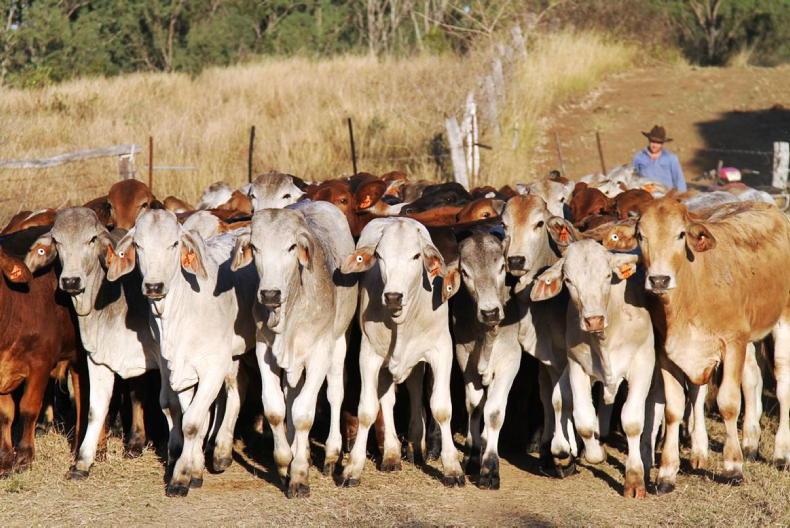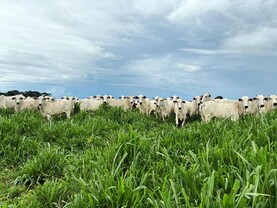European Union (EU) beef imports are projected to increase by 5% in 2024, according to a European Commission report.
In its short-term outlook for EU agricultural markets in 2023 and 2024, the Commission said that this “modest” 5% increase will come off the back of a 2.5% decline in EU beef imports between January and June this year.
“The main reason is that imports from the UK are decreasing substantially (down 20% January to June) due to lower slaughterings in the UK,” the Commission said.
The outlook report explains that the drop in beef imports from the UK, the EU’s main trading partner, has not been compensated for by increased imports from Brazil and Argentina for the first half of 2023.
“These [countries] find also rewarding markets in other parts of the world, thanks to a relatively tight beef market at global level,” the Commission said.
However, the report suggested that it will be the relaxation of these market conditions in 2024 that will see more Brazilian and Argentinian beef sent to the EU.
Consumption
The consumption of beef by EU consumers is projected to have decreased by 3.5% for 2023, according to the Commission report.
The Commission said by the end of the year, EU beef consumption per capita will have dropped to slightly less than 10kg.

EU beef consumption fell in 2023. \ Donal O' Leary
Such a decline in consumption is down to a 3.1% decline in EU beef production for the year overall, this not being replaced by imports, and the current high inflation which is reducing consumer beef purchases or pushing the consumer to cheaper animal proteins.
However, despite the 3.5% downturn for 2023, the market analysis predicts that there will be a much smaller drop in EU beef consumption in 2024, of 1%.
Production
The report found that over the first half of 2023, EU beef production reduced by 4.5%, mainly due to a significant decrease in the cattle kill in Italy, down 23%.
The Commission found that grazing conditions were mediocre in some parts of the EU due to dry weather and feed prices were still relatively high, although on a declining path. This lower beef supply continues to support EU beef producer prices, it said.
“By the end of the year, beef production is expected to recover slightly thanks to lower feed prices and higher carcase weights. Some additional slaughterings linked to forage shortage at farm level in some EU countries is expected.
“Overall, a reduction in production of 3.1% in 2023 is foreseen on a yearly basis. If feed prices continue to decrease and make the fattening process more profitable, a smaller reduction of 1% might be expected in 2024, closer to the structural declining trend seen in previous years,” the Commission said.
Exports
Analysis by the Commission found that as the beef supply in the EU is lower, domestic prices may stay relatively high, having a negative impact on the competitiveness of EU beef exports.

EU farmers will be competing with more beef imports next year.
The Turkish market reopened for beef imports, leading to additional shipments of live animals and meat starting from January this year and reaching around 10,000t per month in May.
The Moroccan market has also reopened for live trade and there has been a 2% increase in meat demand from the UK over 2023 so far.
However, these changes do not cover the losses of meat exports in high-value markets such as Norway, Japan and the US, the Commission said.
Read more
Mercosur beef output increases as EU declines
European Union (EU) beef imports are projected to increase by 5% in 2024, according to a European Commission report.
In its short-term outlook for EU agricultural markets in 2023 and 2024, the Commission said that this “modest” 5% increase will come off the back of a 2.5% decline in EU beef imports between January and June this year.
“The main reason is that imports from the UK are decreasing substantially (down 20% January to June) due to lower slaughterings in the UK,” the Commission said.
The outlook report explains that the drop in beef imports from the UK, the EU’s main trading partner, has not been compensated for by increased imports from Brazil and Argentina for the first half of 2023.
“These [countries] find also rewarding markets in other parts of the world, thanks to a relatively tight beef market at global level,” the Commission said.
However, the report suggested that it will be the relaxation of these market conditions in 2024 that will see more Brazilian and Argentinian beef sent to the EU.
Consumption
The consumption of beef by EU consumers is projected to have decreased by 3.5% for 2023, according to the Commission report.
The Commission said by the end of the year, EU beef consumption per capita will have dropped to slightly less than 10kg.

EU beef consumption fell in 2023. \ Donal O' Leary
Such a decline in consumption is down to a 3.1% decline in EU beef production for the year overall, this not being replaced by imports, and the current high inflation which is reducing consumer beef purchases or pushing the consumer to cheaper animal proteins.
However, despite the 3.5% downturn for 2023, the market analysis predicts that there will be a much smaller drop in EU beef consumption in 2024, of 1%.
Production
The report found that over the first half of 2023, EU beef production reduced by 4.5%, mainly due to a significant decrease in the cattle kill in Italy, down 23%.
The Commission found that grazing conditions were mediocre in some parts of the EU due to dry weather and feed prices were still relatively high, although on a declining path. This lower beef supply continues to support EU beef producer prices, it said.
“By the end of the year, beef production is expected to recover slightly thanks to lower feed prices and higher carcase weights. Some additional slaughterings linked to forage shortage at farm level in some EU countries is expected.
“Overall, a reduction in production of 3.1% in 2023 is foreseen on a yearly basis. If feed prices continue to decrease and make the fattening process more profitable, a smaller reduction of 1% might be expected in 2024, closer to the structural declining trend seen in previous years,” the Commission said.
Exports
Analysis by the Commission found that as the beef supply in the EU is lower, domestic prices may stay relatively high, having a negative impact on the competitiveness of EU beef exports.

EU farmers will be competing with more beef imports next year.
The Turkish market reopened for beef imports, leading to additional shipments of live animals and meat starting from January this year and reaching around 10,000t per month in May.
The Moroccan market has also reopened for live trade and there has been a 2% increase in meat demand from the UK over 2023 so far.
However, these changes do not cover the losses of meat exports in high-value markets such as Norway, Japan and the US, the Commission said.
Read more
Mercosur beef output increases as EU declines








 This is a subscriber-only article
This is a subscriber-only article










SHARING OPTIONS: